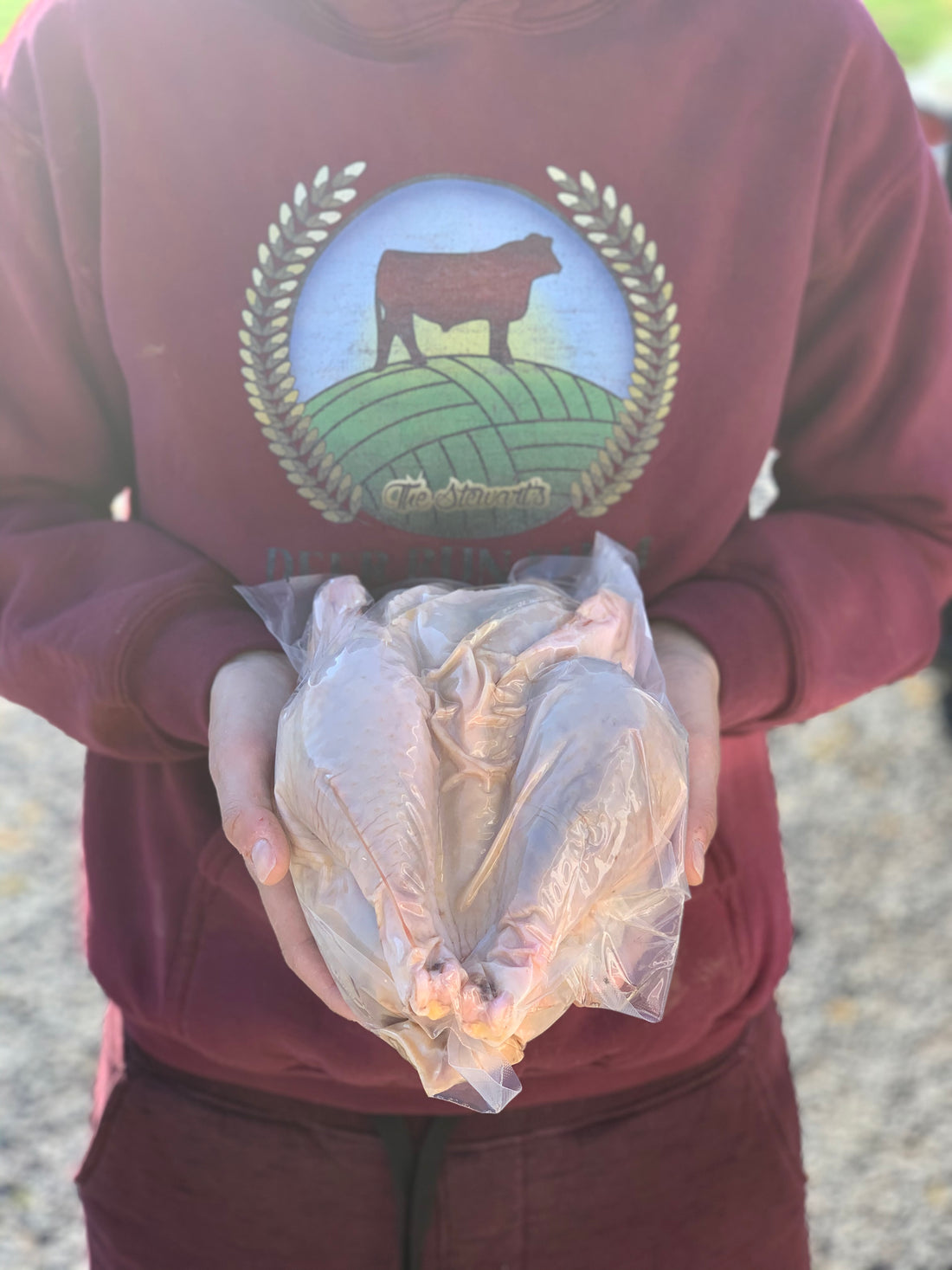I was recently asked to stop offering my chicken meat on a local food platform. This incident struck a nerve with me. You see, I don’t raise your average grocery store chicken, nor do I raise my chickens in confinement like much of the commercial industry. In fact, I don’t even raise the same chicken that most other pastured poultry farmers do. I’m old school. I raise heritage breeds of poultry: specifically, Delaware, Marans and Welsummer chickens for meat.
There’s a huge disconnect between consumers and producers when it comes to the poultry industry. As farmers, it’s our job to educate and bring awareness to our consumers about the industry.
I was asked to stop offering my pasture raised, heritage chicken because a few consumers were unable to prepare it properly for it to be edible for their meal. It should be understood that heritage chickens cannot be compared to what is offered elsewhere and therefore should not be expected to prepare the same way as other, more common chicken. Rather, heritage chicken is very much different in the way it is both raised and how it should be prepared.
Let’s look at the poultry industry as a whole first. Did you know that there are only three companies in the world that control the poultry meat industry? Only three: Aviagen, Cobb Vantress (owned by Tyson) and Hubbard. These multinational companies spend billions of dollars every year to further improve the poultry genetics they own. You may be asking yourself how it is possible for just three companies to control the entire world’s poultry meat industry right now?
It started with a contest in the 1950’s called “The Chicken of Tomorrow” hosted by the Atlantic and Pacific Tea Company. The contest encouraged participants to develop a meatier bird that resulted in the creation of the Cornish Cross.
The Cornish Cross is the hybrid offspring of the Cornish and White Plymouth Rock. This hybrid cross quickly became the breed of choice for broiler operations after the contest for their ability to reach 5lb table weight at just 6 to 7 weeks old. This has been an opportunity for farmers to maximize their profits by raising a breed of chicken with a quick turnover and a super efficient feed conversion.
While this seems like a no brainer for a farmer to jump on the bandwagon and raise a breed for quick profit, it’s much more complicated than the industry reveals. In fact, without over 50 years of selectively breeding the perfect genetics with one another, this rapid growth bird would be nonexistent.
But, how did only three companies come to control the entire world’s poultry meat industry? The answer is simple: money.
It takes several millions of dollars to grow a business to a national level. The companies of the poultry industry are no different. Aviagen, Cobb Vantress and Hubbard all arrived to their reigning territory of the industry by spending lots and lots of money on science, data, and genetics. Over 5 decades of breeding Cornish with White Plymouth Rocks and measuring their offspring for growth traits, body composition and production has led to the very specific Cornish Cross broiler of today.
These companies have actually patented the genetics they own, making it impossible for any outsider to just obtain the genetic makeup of today’s Cornish Cross and begin to sell their own. Unlike your average meat chicken from the early 1900s, today’s meat bird doesn’t live long enough to reach maturity where it may reproduce. This makes it impossible for someone raising these broilers to breed and hatch their own future offspring.
Aviagen, Cobb Vantress and Hubbard use a 4-way cross breeding system to protect their genetics and keep them secret to the rest of the industry. This 4-way crossing produces the parents of the broiler chicks offered to farmers by independent hatcheries. This means it’s actually the genetics of the grandparents that are patented and would never be able to be reproduced by the Cornish Cross that the average farmer raises.
These companies are so savvy with their genetics that they each have their own strains for different purposes. Some strains are designed to produce broad breasted birds for the consumer’s demand of white meat. They’ve also developed strains for a slower growing bird to fit the farmer’s need to raise them in a different environment. The fact is, these genetics cannot be reproduced tomorrow. It would take another 50+ years of selective breeding to get to where these companies are now with their genetics.
If we’re being realistic about the poultry meat industry as it is today, it’s not sustainable. While it’s a sufficient means to feed America right now, how can we be assured that it will still be as sufficient tomorrow if only three companies are running the show?
Let me break it down for you.
Majority, if not all, of the chicken sold in grocery stores, at restaurants or further processed into your McDonald’s Nuggets is the product of genetics from either Aviagen, Cobb Vantress or Hubbard. Even the non-GMO, grain free, soy free, certified organic, pasture raised, all natural chicken offered by your farmer at the local farmers’ market is likely the product of genetics from those same companies.
The Cornish Cross has become so convenient for growers and consumers alike. The growers turn over product quickly, which results in higher profit and the consumers get an endless supply of chicken that’s convenient to prepare. All this is great, but at what cost to the sustainability of the industry?
If farmers have to rely on hatcheries for their chicks and hatcheries on egg suppliers and egg suppliers on the genetics withheld by the big companies, what would happen if those companies just went away? Or worse, what if those companies lost all of their data or took on a disease that wiped their original stock and genetics out?
Without using heritage chickens that can be bred normally through natural process, the poultry meat industry would be obsolete. There’s a meaning to the phrase, “you shouldn’t put all of your eggs in one basket” and I do believe it’s relevant in the case of the Cornish Cross.
I raise heritage chicken for meat to be the other egg in a different basket.
It’s important to me that I educate the consumer and offer another option (and an original option that our great grandparents used to enjoy!) of chicken that is sustainable for the sake of the industry.
Heritage chicken breeds are not rapid growing birds and look very different than the Cornish Cross. They can take up to 18-20 weeks to reach a good table weight and their bodies will be much more slender and elongated than that of the Cornish Cross.
While it may take me longer to produce my chicken and cost me a bit more to do so, my chickens can live long, healthy lives without abruptly dying because they’ve outgrown their own bodies and organs like the Cornish Cross. My chickens can reach maturity and therefore be able to reproduce ensuring the safety and resiliency of our poultry meat supply. On top of it all, a properly prepared heritage chicken will taste nothing like a store bought bird. It will be more flavorful and have some of the darkest meat one will ever see.
Of course, there are still hurdles to over come in the “heritage chicken for meat” business. The fact that I was asked to stop offering mine on a local food platform is one of them. As a dedicated breeder, I, too, can produce a heritage chicken that can one day compete with the Cornish Cross as a popular meat bird. Selectively breeding my own stock year after year to increase the genetic pool for rapid growth and broader chests is the first step. Convincing the consumer to give heritage chicken a try and providing the right education on how to prepare a heritage bird for a meal is step two. In the case of the local food platform, I wasn’t given the proper opportunity to offer step two. Since then, however, I was able to offer the necessary education and be given the chance to sell my heritage chicken with the proper preparation instructions along with a solid education for the consumer about why it’s important to eat more heritage birds.
I believe there is a need for independence from the genetic leaders in the poultry meat industry. Without it there’s no way to provide a form of poultry meat sustainability. If we continue to push the genetics of the current industry leaders, we risk losing all heritage stock for meat that’s capable of reproducing which is the equivalent to maintaining poultry meat sustainability.
A world that consumes 50 billion chickens annually is not a world that can rely solely on three companies to maintain the industry. It’s important for heritage breed chicken owners, breeders and growers to join the movement and start breeding and eating more heritage birds. Through education and understanding of the current poultry meat industry, it’s possible to bring heritage chicken for meat back into grocery stores, back onto more local food platforms and most importantly back on the family’s dinner table!


5 comments
This article is very interesting and to the point. Heritage chicken are a guarantee for chicken production of the future. They are here to stay. Viva heritage chicken, viva
Marcos
Thank you for posting this explanation. While the work you do raising food is hard, teaching the world about the issues facing our food supply adds a lot to it. Keep up the great work!
This is much needed education and good writing!
Excellent post. Thank you for sharing.
can you tell us how to properly prepare a heritage chicken? I am very very new to raising chickens and would like to learn more before I get started with raising chickens for meat and not just eggs.
Thank you